Local conditioning in posterior sampling methods with example cases in subsurface inversion
IF 4.2
2区 地球科学
Q1 COMPUTER SCIENCE, INTERDISCIPLINARY APPLICATIONS
引用次数: 0
Abstract
Local approaches have gained interest because they can provide fast approximate solutions for inverse problems. Following the idea of split-and-conquer, one aims to effectively condition variables to data using only small parts of the big model. We study and compare local approaches for conditioning in the context of seismic amplitude data and tomography, with two datasets relevant to improved oil and gas recovery in the North Sea and groundwater characterization in Denmark. In our comparison we study a local variant of an extended rejection sampler, termed localized extended rejection sampler (LERS), and a local ensemble transform Kalman filter (LETKF). Using various output statistics, we investigate the performance of the methods at marginal (e.g. mean and variance) level and joint properties (e.g. volume uncertainty and connectivity) of the subsurface variables of interest. Computed posterior statistics are compared with a reference Markov chain Monte Carlo solution. The results highlight benefits of the methods, such as fast reliable performance on the marginal properties, while joint properties in the more difficult cases show potential challenges of applying these local methodologies. Based on the results in our two cases, we discuss the applicability of the methods. We conclude that the localization methods are efficient and useful for estimating marginal properties and associated uncertainty, and can be an inexpensive tool for evaluating the need for further data processing. Local assimilation as outlined here is not suitable for generating posterior realizations of the spatial process variables.
后验抽样方法中的局部调节,并附地下反演实例
局部方法因其能提供逆问题的快速近似解而受到人们的关注。遵循分而治之的思想,我们的目标是仅使用大模型的一小部分有效地将变量约束为数据。在地震振幅数据和层析成像的背景下,我们研究并比较了当地的调节方法,其中包括北海提高油气采收率和丹麦地下水特征的两个数据集。在我们的比较中,我们研究了扩展抑制采样器的局部变体,称为局部扩展抑制采样器(LERS)和局部集成变换卡尔曼滤波器(LETKF)。使用各种输出统计数据,我们研究了方法在边际(例如均值和方差)水平和联合属性(例如体积不确定性和连通性)下感兴趣的地下变量的性能。计算后验统计量与参考马尔可夫链蒙特卡罗解决方案进行了比较。结果突出了这些方法的优点,例如在边缘属性上快速可靠的性能,而在更困难的情况下,联合属性显示了应用这些局部方法的潜在挑战。根据这两个案例的结果,讨论了方法的适用性。我们得出的结论是,定位方法对于估计边缘属性和相关不确定性是有效和有用的,并且可以作为评估进一步数据处理需求的廉价工具。这里概述的局部同化不适用于生成空间过程变量的后验实现。
本文章由计算机程序翻译,如有差异,请以英文原文为准。
求助全文
约1分钟内获得全文
求助全文
来源期刊

Computers & Geosciences
地学-地球科学综合
CiteScore
9.30
自引率
6.80%
发文量
164
审稿时长
3.4 months
期刊介绍:
Computers & Geosciences publishes high impact, original research at the interface between Computer Sciences and Geosciences. Publications should apply modern computer science paradigms, whether computational or informatics-based, to address problems in the geosciences.
 求助内容:
求助内容: 应助结果提醒方式:
应助结果提醒方式:


